Thai yellow curry or แกงกะหรี่ is a classic Thai dish that's a staple in Thai restaurants overseas, and popular amongst Thais and foreigners alike. It's rich with coconut milk, full of aromatic spices, and it's a mildly-spiced curry I recommend for those with low heat tolerance, even kids. If you buy the curry paste ready-made, or make it in advance, it's an easy and quick weeknight meal.

Want to save this recipe?
What is Thai Yellow Curry?
"Yellow curry" as it is popularly known in English, is a rich, mildly spiced curry that is made usually with chicken or beef, and with potatoes and onions. The yellow colour comes from turmeric, which is added fresh to the curry paste, and also dried as part of the curry powder that is also in the paste.
It's called gaeng garee or kaeng karee in Thai which is an interesting name because gaeng means curry, and garee...well...also means curry! So it is...curry curry? Let me explain.
Gaeng means curry in the Thai sense. It refers to soupy Thai dishes that are flavoured with a paste of herbs and spices. Garee refers to the use of curry powder (an Indian influence on Thai cuisine), which is what makes yellow curry rather unique when compared to other Thai curries such as red curry or green curry, which don't have much dried spices in them. This is why when you eat gaeng garee it can feel reminiscent of an Indian curry!
In Thailand, gaeng garee is a specialty of Thai Muslims, which is why you'll only find yellow curry made with chicken, beef or even goat, and almost never pork!
Not To Be Confused With...The Other Yellow Curry
If you were in Thailand and you asked for a dish that is literally named "yellow curry" or gaeng leuang, you will end up with something very, very different!
Gaeng leuang is a sour water-based curry that comes from Southern Thailand, similar to this gaeng som recipe. The yellow also comes from the use of turmeric, but that is where similarities end. It is brothy as it has no coconut milk, the main flavour is sour, and it is extremely spicy.

This is important to know because my friend has accidentally bought the wrong curry paste and ended up with nearly inedibly spicy curry (for them) with all the wrong flavour! In the export market, Maesri brand sells "yellow sour curry paste" (pic above), and it is easy for your eyes to miss the "sour." The correct paste from Maesri is labelled as "karee curry paste" (as of today anyway, as packaging does change).
Watch The Full Video Tutorial!
All my recipes come with step-by-step video tutorials with extra tips not mentioned in the blog post, so make sure you watch the video below to ensure success - and if you enjoy the show, please consider subscribing to my YouTube channel. Thank you!
Ingredients and Notes
Here are all the ingredients you need and important notes about them. For amounts, see the full recipe card below.
- Yellow curry paste, store bought or homemade using this recipe. For store bought, I like Maeploy and Aroy-D brand, but Maesri is also a good choice. Note that Maesri labels their yellow curry paste as "Karee Curry Paste," and do NOT get the one labelled "yellow sour curry" as that's an entirely different dish.
- Bone-in chicken thighs. Chicken is the most common meat pairing for Thai yellow curry, but yellow curry with beef if also common. You can also use braise-friendly cuts or pork such as pork butt. Bone-in chicken thighs will result in the most flavourful sauce, but in a pinch, boneless chicken thighs will also work.
- Coconut milk. Not sure which is the best coconut milk to get? See my post here with everything you need to know about coconut milk including the best coconut milk to buy.
- Waxy potatoes such as new or red skin potatoes. Starchy potatoes such as russet will also taste great, but you have to be very careful not to overcook them as they disintegrate easily. Yellow sweet potatoes, such as Korean sweet potatoes, also work well in this dish.
- Yellow or white onion.
- Fish sauce. If you're new to fish sauce, see my post all about fish sauce and how to choose a good one!
- Palm sugar or light brown sugar. Learn more about palm sugar here.
- Tamarind paste, store bought or homemade using this homemade tamarind paste recipe.
- Cherry tomatoes or grape tomatoes. These are optional, but they do add a nice colour and a lovely tang to help balance the richness. If you don't have them you can also add some carrots to get the pop of colour.
- Fried shallots. Optional for garnish. You can buy them at Asian markets or make your own following these instructions.
- Jasmine rice for serving
How to Make Thai Yellow Curry
Here's a bird's eye view of the steps for making yellow curry. When you're ready to cook, refer to the full written recipe below, and watch the video tutorial to ensure success!
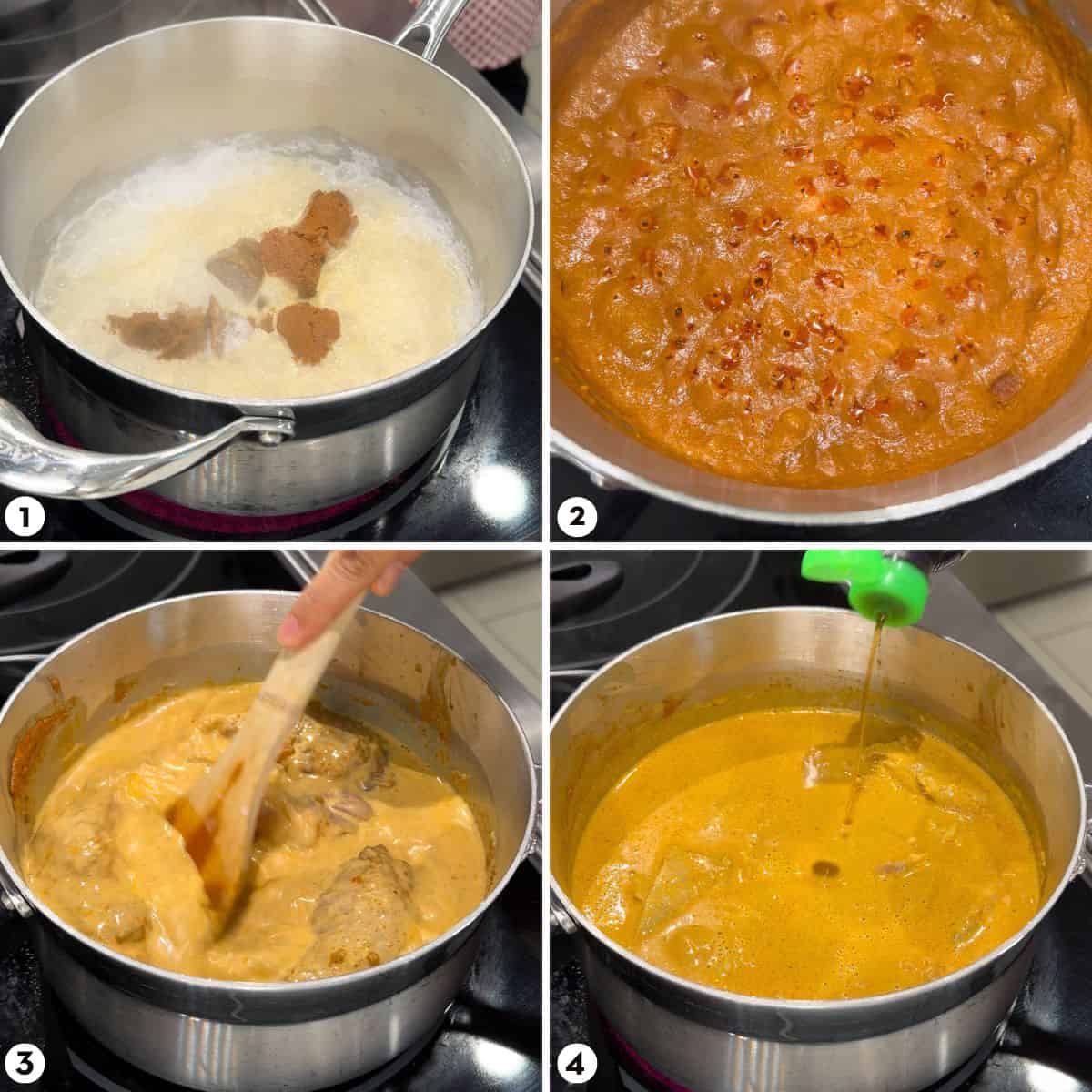
- Bring ¾ cup of the coconut milk to a boil and add the curry paste.
- Stir the curry paste mixture over medium heat until very thick and coconut oil starts to separate from the paste.
- Add the remaining coconut milk, water and chicken and stir to mix.
- Add the fish sauce, sugar and tamarind and simmer for 30 minutes.

- Add potatoes and onion and simmer for another 15 minutes or until chicken is fork tender and the potatoes are fully cooked (in the pic I also added some carrots). While the curry cooks, pierce the cherry tomatoes (if using) with a paring knife to create a steam vent so they don't explode in your mouth.
- Once curry is done, taste and adjust seasoning with more fish sauce, sugar or tamarind as needed. If using cherry tomatoes, turn off the heat and add them in now and let the residual heat of the cook the tomatoes for a few minutes.
- If using store bought fried shallots, give them a quick toast in a dry skillet for a few minutes to refresh and crisp them up.
- Serve with jasmine rice and sprinkle the fried shallots on top, if desired.
Tips for Success and Advance Prep
There are a couple of important things to note in this recipe:
- Avoid using chicken breast. Dark meat chicken can be slow-braised until tender, and this gives the meat time to absorb the flavour of the curry. If you slow-braised white meat, it just turns dry and stringy.
- Piercing tomatoes prevents explosions. While you can use halved cherry tomatoes in this, if you know that you will be reheating leftovers, halved tomatoes will likely disintegrate into the curry. Not a huge problem, but not ideal. However, using whole cherry tomatoes can be a bit dangerous because if the tomatoes are heated, but not enough for the skin to break, they become hot water balloons that can burst and burn your mouth when you bite into them! Piercing them prior to cooking allows excess heat and steam to escape so they won't explode.
- Make the curry a day ahead. As with many stews, yellow curry tastes better the next day after the flavours have had time to penetrate the potatoes and chicken more thoroughly. So this is a recipe that really benefits from an overnight rest. I would add the tomatoes the day-of if possible.
- Leftover curry sauce? Use it as a dip! Thai people often dip roti paratha (which you can buy frozen) in yellow curry sauce. So if you have some curry sauce left, you can dip any kind of flat bread or even slices of toast into it as a quick appetizer.
Storing Leftovers
Yellow curry keeps very well. It'll last at least a week in the fridge, and will taste even better the next day.
When reheating be careful not to overcook the potatoes and tomatoes. I find microwaving better for this, as the stove top takes longer to heat the inside through, making it more likely for the potatoes to be overcooked.
Recipe Card
Print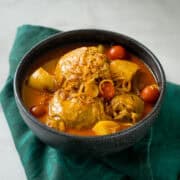
Authentic Thai Yellow Curry with Chicken and Potatoes
- Prep Time: 20 mins
- Cook Time: 1 hour
- Total Time: 1 hour 20 minutes
- Yield: Serves 4
Description
Tender braised chicken in rich and aromatic coconut curry sauce, loaded with spices, yellow curry is easy to make and always a crowd pleaser. It's mildly spiced and keeps well, perfect for meal prep!
Ingredients
- 5-6 tablespoons (75-90 ml) store-bought yellow curry paste (note 1), or half of this yellow curry paste recipe
- 2 lb (900 g) bone-in chicken thighs
- 2 cups (480 ml) coconut milk
- 10.5 oz (300 g) waxy potatoes, cut in 1-inch chunks
- Half a medium onion, cut in 1 cm strips
- 1 cup (240 ml) water, or as needed
- 1-2 tablespoons (15-30 ml) fish sauce
- 1 ½ tablespoons (18 g) palm sugar, finely chopped, packed
- 1-2 tablespoons (15-20 ml) tamarind paste, store bought or homemade (note 2)
- 1 cup (100 g) cherry or grape tomatoes
- Optional garnish: fried shallots, store bought or homemade
- Jasmine rice for serving
Want to save this recipe?
Instructions
- In a medium pot, bring ¾ cup (180 ml) of the coconut milk to a boil over medium high heat. Add the curry paste and mix well, then turn the heat down to medium. Keep stirring until the mixture is very thick, and the coconut oil separates from the paste. (The oil may not separate depending on the coconut milk you're using. This is okay, just move on.)
- Add the remaining coconut milk and stir to mix. Then add the chicken, 1 tablespoon of fish sauce, 1 tablespoon palm sugar, 1 tablespoon of tamarind, and just enough water to keep the chicken barely submerged. Bring to a simmer, and let the chicken simmer gently for 30 minutes.
- Meanwhile, pierce the cherry tomatoes with the tip of a parting knife, making about a half-inch incision. This is to create a vent for hot tomato juice to exit, preventing them from exploding in your mouth!
- Once the chicken is done, add the potatoes and onion and simmer for another 15 minutes or until chicken is fork tender and the potatoes are fully cooked. Top it up with more water as needed to keep the potatoes barely submerged.
- Taste and adjust seasoning with the remaining fish sauce, sugar and tamarind as needed. Turn off the heat and immediately stir in the pierced cherry tomatoes and let the residual heat of the curry gently cook the tomatoes for a few minutes before serving.
- Sprinkle with fried shallots, if desired. Serve with jasmine rice.
Notes
- For store bought I recommend Maeploy or Aroy-D brands. I don't recommend Thai Kitchen as it is very weak.
- Tamarind paste is sometimes sold as "tamarind concentrate." Be sure the buy a product of Thailand or Vietnam, and it should be brown colour with a relatively loose consistency. Do not use the black, sticky Indian tamarind concentrate.

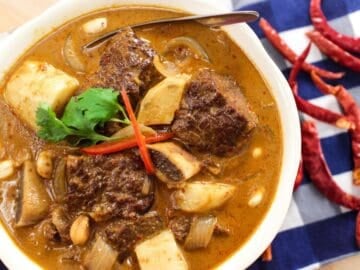
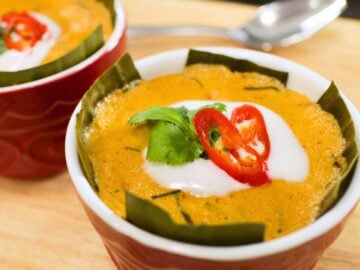
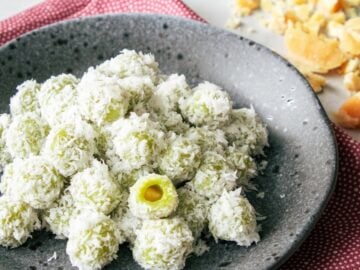
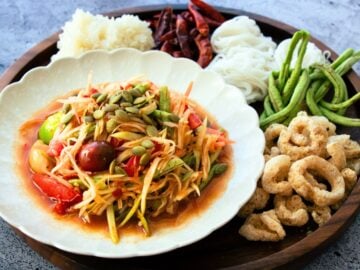
Mike says
Very good recipe; however, next time I’ll add half the fish sauce as it was way too salty. I ended up having to add extra sugar and water to balance it out some but it was still too salty. Use Mae Ploy yellow curry paste.
Paul L says
This was a very flavorful recipe! My sister rated it as a ‘Make Again’ dish. Thank you.
Katherine says
Excellent and tasty! I wound up adding additional coconut milk + paste to get it as wet as I like. I have very good results with Maesri brand curry pastes.
My chicken cooked faster than stated per my thermometer, so I removed it with a slotted spoon and then added the potatoes and onions to cook by themselves.
Paul says
You don't mention, but are the chicken thigh skins removed or kept?
Pailin Chongchitnant says
I used skin-on but it doesn't matter for the recipe, so leave them if you like to eat the skin, otherwise you can remove them 🙂
Lynn says
Love this recipe! A great week night dinner!
Easy to make. I do add some carrots just because I love carrots!
Stephen Chan says
It’s a bit like Malaysian curry but thinner, delicious anyway, that’s what matters right?
Alyssa says
My husband and I really enjoyed this recipe. I didn’t find it too salty at all. I followed the recipe except I used thinly sliced chicken breasts and carrots, it turned out great. Thank you!!!
Don Carr says
I made this dish with and without chicken bones. Both versions were fantastic!!!
Mari Quiambao says
I love your recipes! I made this and really enjoyed it. I was surprised to see tamarind paste. Didn't have it so substituted powder, about 1 to 2 T with 3 oz of water. It was a nice brightener to the curry and made sense after tasting and comparing with/without. I did skip the tomatoes. I happily froze the extra curry for later use. So happy I found your site. A good friend had a Thai restaurant (my first try if Thai food) and I can never find a restaurant that measures up to her flavors. I now have decided to make everything myself including the curry recipes from scratch. Glad I found your site. Thanks!😋
Sherry says
Made this for dinner tonight and it was absolutely delicious! Better than our local Thai restaurant. Used Mae Ploy yellow curry paste and the heat level was just perfect for us. Also used some coconut cream in the curry as we like it more creamy. This will be our go to yellow curry recipe!
Nick says
Pai,
I just want to check the accuracy of the recipe.
I don't add the Tamarind paste until the very end, when I am doing the final seasoning, is that correct?
Making it this Sunday!
Pailin Chongchitnant says
Sorry didn't get to this before sunday! Hope it turned out anyway. Yes, in this recipe I add it at the end (I will adjust the recipe wording to clarify). However it isn't necessary. You CAN add about half of the tamarind in the beginning, and save the rest to adjust. This is because tartness of tamarind varies significantly, so adding it all in the beginning can be a little risky.
Craig Garver says
Making this right now, really excellent flavor. I was skeptical of the tamarind juice because I've just never encountered it in a yellow curry recipe before, but it definitely adds quite a bit to the flavor. Not cooking the curry in oil first and just doing it in the coconut oil definitely is much better than other recipes I've used. Very highly impressed!
Vineeta Gogia says
Thank you for sharing this recipe.
I made it and it tasted delicious.
Tim says
OMG. I just had this again for dinner and I am so happy now! This curry is very easy and doable. As a substitute for potato I used, as it is called in the local markets here, Boniato (or Batata) Oriental. It is white-fleshed, holds its shape well and is just slightly sweet. I you live in an area with a large Latino community, there are several tubers which work well in Thai curries.
Ian says
Really good!